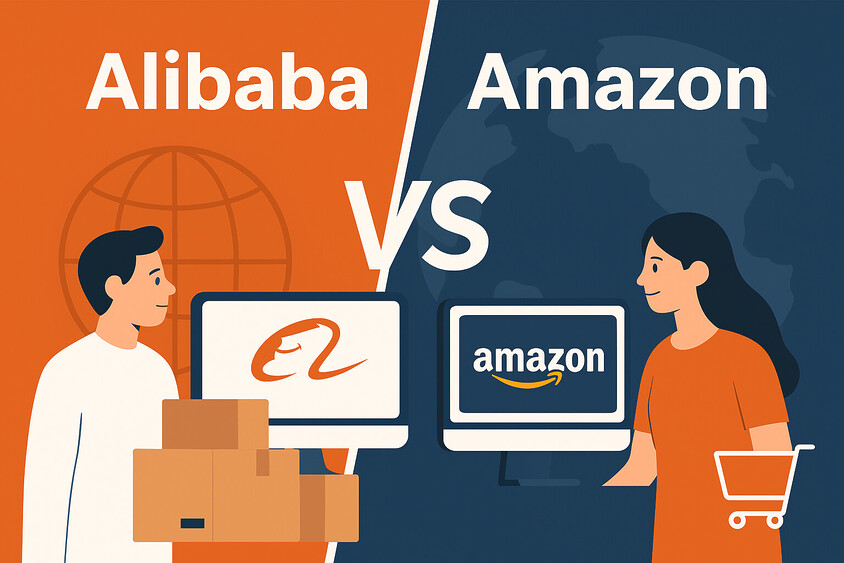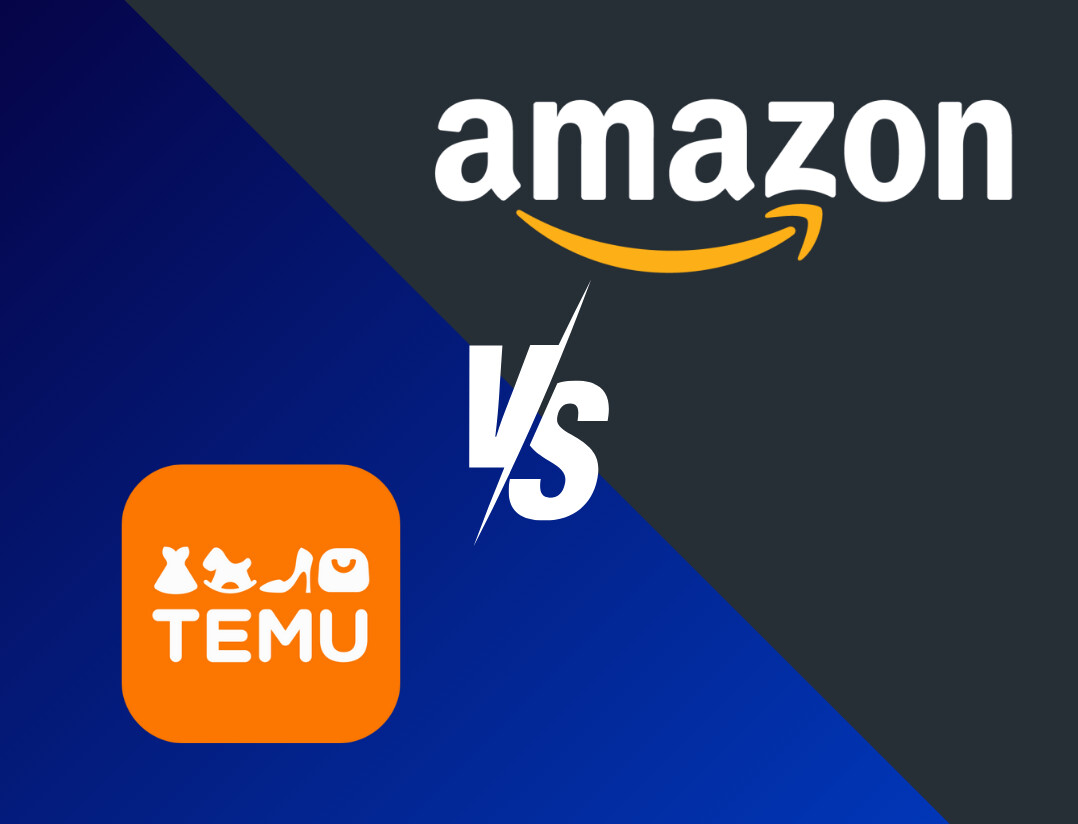Alibaba vs. Amazon – Differences and Opportunities for Sellers

While both companies are e-commerce industry giants, they are quite different from one other, especially when comparing business models, audience operations, fees and how sellers can use these elements to their benefit. In this Alibaba vs. Amazon article, we will go into detail regarding all these elements and how you as a seller can make the most of it.
TL;DR – Alibaba vs. Amazon
The Two Platforms at a Glance
What Is Amazon?
Amazon is mainly a B2C marketplace, which means it connects businesses directly to consumers. Very simply put, Amazon is basically an online shopping mall where anyone can buy almost anything – from books to electronics to groceries.
It’s designed for everyday shoppers. People visit Amazon to buy ready-made products, not to negotiate bulk deals.
For sellers, Amazon offers a huge global audience. Millions of people visit the site every day, making it the optimal platform to sell on if reach is important to your business.
Amazon also offers tools and services to improve the selling experience. The most successful solution being Fulfillment by Amazon (FBA). With FBA, Amazon stores your products, packs them, ships them, and even handles customer service.
In short – when you compare Amazon versus Alibaba – you can keep in mind that Amazon is a place to sell finished products directly to customers. As a seller, you can also count with support from Amazon or third-party tool providers with almost everything along the way.
What Is Alibaba?
Alibaba works differently. Being mainly a B2B platform, it usually connects e-commerce businesses to manufacturers or wholesalers.
If you are looking to buy products in bulk, Alibaba is your go-to address. Instead of selling one particular phone case, for example, suppliers on Alibaba will look to provide you with bulk deals that go into the hundreds and thousands per purchase.
This makes Alibaba ideal for companies that want to create their own products or brands. Many Amazon sellers actually buy from Alibaba, add their own logo or packaging, and then sell those items on Amazon.
So, while Amazon is where customers shop, Alibaba is where businesses shop to sell the shopped items themself.
In simple terms:
Both platforms are highly relevant for e-commerce, but they serve different purposes in the global trade chain.
Key Differences – Alibaba Versus Amazon
Let’s take a closer look at the differences between the two platforms. As mentioned earlier, their business models, customers, and goals are very different.
1. Business Model
Amazon focuses mainly on B2C (business-to-consumer) sales. This means it connects sellers directly with shoppers who want to buy finished products. It also allows third-party sellers to offer their goods on its platform, giving customers more choices.
Alibaba, on the other hand, is mainly B2B (business-to-business). It connects manufacturers and wholesalers with other businesses that buy in bulk. While Alibaba does have some B2C platforms (like AliExpress), its core focus remains business sourcing and trade.
2. Customer / Buyer Base
Amazon’s buyers are everyday consumers. They usually place smaller, individual orders and expect fast delivery, great service, and easy returns.
Alibaba’s buyers are mostly businesses or resellers. They place large bulk orders, often negotiate prices, request customization, and manage longer supply chains.

3. Fulfillment & Logistics
Amazon handles logistics mainly through Fulfillment by Amazon (FBA). This service includes storage, packaging, shipping, and customer service. While other shipping methods are available on the platform, Amazon FBA is by far the most popular with sellers and buyers alike.
Alibaba does not offer a service similar to FBA. It mainly connects buyers and suppliers, but doesn’t fulfill orders itself. Shipping and logistics are usually arranged directly between the buyer and the supplier.
4. Product Offering & Sourcing
Amazon and sellers on Amazon sell a wide variety of ready-to-buy products. These range from household name brands to private label products that are manufactured by sellers. Amazon follows a retail model, where consumers shop for finished, branded goods.
Alibaba is used for sourcing products from factories or manufacturers. Many items are unbranded or customizable, and buyers often need to meet minimum order quantities (MOQs).
5. Geographic Focus & Market Reach
When comparing Alibaba vs. Amazon, it becomes apparent that the latter is strongest in Western markets such as the U.S. and Europe, but it also operates globally.
Alibaba dominates in China and across Asia, though it also acts as a global trade bridge. Most of its suppliers are export-oriented, producing goods for international markets.
6. Fee & Revenue Models
Amazon has multiple income sources. It earns from product sales, commissions, seller fees, FBA services, and subscriptions like Amazon Prime.
Alibaba earns mainly from membership fees, advertising, and transaction services. Unlike Amazon, it doesn’t hold inventory or handle most order fulfillment directly.
7. Risk, Competition & Control for Sellers
Amazon sellers face high competition, not just from other sellers but also from Amazon itself, which often sells similar products. The platform also has strict rules, and account health plays a big role in success.
Alibaba sellers deal with different challenges – these range from quality control issues, longer shipping times, supplier reliability, and intellectual property risks. Buyers must carefully vet suppliers to avoid problems.
Best of Both Worlds – Leveraging Alibaba and Amazon
Sourcing on Alibaba and selling on Amazon is the way to go – and also what most sellers do.
What’s your goal?
Looking to reach customers directly? Then Amazon is the right place. Gain access to millions of shoppers who are ready to buy. List your products, manage your pricing, and use Amazon FBA to handle storage and shipping.
Finding products to sell is best done on Alibaba. It connects you to thousands of manufacturers and suppliers. Order in bulk, request samples, and even customize your products.
Here’s how you make it work:
Source products from Alibaba and sell them on Amazon. Many private label sellers follow this method because it enables them to control their brand, pricing, and often leaves them with a higher profit margin than sourcing locally.
Consider logistics.
Logistics differ considerably when comparing Alibaba vs. Amazon. Alibaba suppliers ship internationally, which can take weeks. You’ll need to plan ahead, calculate shipping and customs costs, and check import rules. Shipping with Amazon, on the other hand, is more flexible, due to Amazon FBA and the vast network of 3PL providers that work closely with Amazon.
Prepare for the marketplace.
Once your products arrive, create Amazon listings with clear titles, quality images, and optimized keywords. Monitor performance and adjust your prices regularly to stay competitive.
In short:
Pros & Cons – Side-by-Side
| Platform | Pros | Cons |
| Amazon | • Unparalleled global audience. • Trusted by buyers worldwide. • Fast, reliable shipping through FBA. • Detailed analytics and advertising tools. | • High competition between sellers. • Rising fees and costs. • Strict performance rules. • Amazon can (and will) compete with your own products. |
| Alibaba | • Direct access to manufacturers. • Low production and sourcing costs. • Customization and private-label options. • Great for bulk orders. | • Long lead and shipping times. • Quality can vary between suppliers. • Communication barriers and time zones. • Upfront payment risks if the supplier isn’t verified. |

Next Steps for Sellers
Looking to use these two platforms Here’s a simple, step-by-step checklist you can follow to go from Alibaba vs. Amazon to Alibaba & Amazon.
Step 1 – Product Research (Amazon)
Research on Amazon to find what customers actually want. This works well with Google Trends or the best seller list on Amazon itself. Look for trending products, profitable niches, and look for customer pain points (especially in reviews of competitors). This helps you choose a product that already has proven demand.
Step 2 – Product Sourcing (Alibaba)
Once you have a good idea for a product, go to Alibaba. Search for suppliers who can produce your product at a good price. Request samples to check quality before placing a bulk order.
Compare offers, verify supplier credentials, and negotiate minimum order quantities (MOQs).
Choose a partner who communicates clearly and delivers consistently.
Step 3 – Cost Calculation (Alibaba + Amazon)
Now combine information from both platforms. From Alibaba, calculate unit price, shipping, and customs costs. From Amazon, add selling fees, storage fees (if using FBA), and advertising expenses. Make sure your final retail price keeps your profit margins healthy.
Step 4 – Shipment Preparation (Alibaba → Amazon)
Work with your Alibaba supplier to arrange packaging and shipment. When it comes to packaging, be sure to follow Amazon’s strict guidelines if you ship by yourself.
Plan your shipping schedule, track your containers, and prepare for customs clearance.
Send your inventory directly to an Amazon fulfillment center if possible.
Step 5 – Listing Setup (Amazon)
Now move fully into Amazon.
Create your product listing with a clear title, concise bullet points, and detailed descriptions.
Use professional images and optimized keywords to attract shoppers.
This is your storefront—make sure it’s convincing and complete.
Step 6 – Launch and Monitor (Amazon)
Launch your product on Amazon and start gathering data.
Set competitive prices, use advertising to increase visibility, and track sales performance.
Respond to reviews, manage your stock, and adjust your strategy based on results.
Step 7 – Optimize and Grow (Alibaba + Amazon)
Once sales are steady, optimize both sides of your operation.
On Amazon, update your listings, test new keywords, and improve conversion rates.
On Alibaba, review your supplier’s performance, negotiate better prices, or explore new product ideas.
Wrapping Up
When comparing Amazon vs Alibaba, you will soon see that they operate in the same e-commerce space, they serve very different purposes. Alibaba is the best place to start when it comes to sourcing – it’s where you find products, build relationships with suppliers, and shape your brand. Amazon is the platform you use to scale – it’s where you reach customers, generate sales, and grow your business.
The most successful sellers don’t choose one over the other. They use both in a smart and connected way. Alibaba becomes your production base, while Amazon becomes your sales engine. Using both platforms, you can take your idea from factory floor to customer doorstep.
If you plan your costs carefully, choose reliable partners, keep your listings engaging and your pricing dynamic, both platforms will work in your favor and your margins will grow.
FAQs
In market value and global retail reach, Amazon is larger. However, Alibaba dominates in wholesale trade volume and B2B transactions, especially in Asia. Both are massive but operate in different segments of e-commerce.
Not exactly. While often compared, Alibaba focuses mainly on B2B and wholesale trade, whereas Amazon centers on B2C retail and fulfillment. Alibaba connects buyers with manufacturers; Amazon connects sellers directly with consumers.
Use Alibaba to source affordable or custom products from manufacturers. Then, sell them on Amazon to reach global consumers. This “source from Alibaba, sell on Amazon” model allows you to control costs, margins, and brand growth efficiently.






